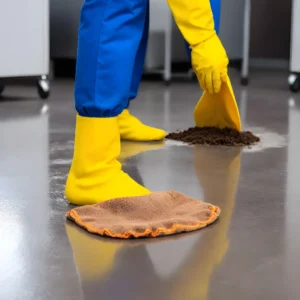Chemical spills can happen in any workplace that uses or stores hazardous materials. While preventing spills is always the best course of action, knowing how to respond effectively is crucial to minimize risk and ensure everyone’s safety. Through this blog get guidance on the most essential steps of how to clean up chemical spills in the workplace.
Prevention is Key
Before diving into cleanup procedures, remember: prevention is paramount. Here are some proactive measures you can take:
- Identify and Label Chemicals: Maintain a comprehensive inventory of all hazardous chemicals in your workplace. Ensure proper labeling with clear information about the chemical’s name, hazards, and safety precautions.
- Invest in Spill Prevention Equipment: Have readily available spill containment materials like berms, pads, and socks in designated locations near chemical storage and handling areas.
- Employee Training: Regularly train employees on proper chemical handling procedures and spill response protocols. This includes recognizing different types of chemicals, using Personal Protective Equipment (PPE), and knowing when to evacuate.
When a Spill Occurs: A Step-by-Step Guide

If a chemical spill does occur, prioritize safety above all else. Here’s a step-by-step approach to guide you:
- Assess the Situation: Don’t rush in! First, evaluate the situation. Identify the spilled chemical (refer to the labels) and its potential hazards (flammability, toxicity, corrosiveness). Is the spill contained, or is it spreading? Are there any fumes or vapors present?
- Evacuate the Area: If the spill poses a threat to anyone’s safety, evacuate the immediate area immediately. Instruct everyone to proceed to a designated safe zone upwind from the spill.
- Contain the Spill: If it’s safe to do so, attempt to contain the spill using appropriate materials like spill berms, pads, or socks. The goal is to prevent the spill from spreading further and potentially reaching drains or other sensitive areas.
- Don Your PPE: Never attempt to clean up a chemical spill without proper Personal Protective Equipment (PPE). The specific type of PPE will depend on the spilled chemical. This may include gloves, safety goggles, respirators, and protective clothing.
- Neutralize the Spill (if applicable): For certain spills, there may be specific neutralizing agents available. However, this should only be attempted if you have been trained on the proper use of these agents for the specific chemical involved. In any case, never mix chemicals unless you are absolutely certain of the safe outcome.
- Clean Up the Spill: Once the spill is contained, use absorbent materials like Absorbent Boom Socks or Granular Absorbents Bags to collect the spilled chemical. Place the collected materials in a designated hazardous waste container for proper disposal.
- Decontaminate the Area: After the spill has been cleaned up, thoroughly decontaminate the affected area. This may involve using specific cleaning solutions or simply washing the area with soap and water. Ensure proper ventilation during decontamination.
- Report the Spill: Document the incident. Report the spill to the appropriate authorities, your supervisor, and any relevant environmental agencies as required by law.
- Dispose of Waste Properly: Never dispose of hazardous waste in regular trash bins. Follow regulations for proper disposal of contaminated materials and used PPE.
Remember:
- If the spill is large or you are unsure how to handle it safely, call emergency services immediately.
- Do not attempt to clean up a spill beyond your training or capabilities.
- Always prioritize your safety and the safety of others.
Additional Tips for Workplace Chemical Spill Preparedness
- Maintain a Safety Data Sheet (SDS) library: Keep readily accessible Safety Data Sheets (SDS) for all hazardous chemicals used in your workplace. The SDS contains vital information about the chemical’s properties, hazards, and safe handling procedures.
- Post Emergency Contact Information: Clearly display emergency contact information for your company’s safety officer, fire department, and poison control center.
- Conduct Regular Drills: Schedule regular spill response drills to ensure employees are familiar with the emergency procedures and comfortable using PPE.
By following these steps and prioritizing safety, you can effectively manage chemical spills in the workplace and minimize the risk of injury, environmental damage, and costly downtime. Remember, a well-prepared workplace is a safe workplace. For more information on how to clean up chemical spills in the workplace, check out our products at spillxorb.com
